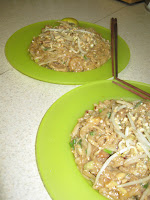Okay, I admit it; I've been slacking on the experimental cooking front. So with a few more weeks off from teaching after my out-of-town work trip, I figured I better get back on the foreign-recipe horse before I lost my motivation to ride. TJ had picked up some great pork loin, and we had leftover shrimp, so I immediately thought of Pad Thai. Clearly, I am out of epicurean practice because I forgot to reserve some of the pork TJ grilled for my noodle dish. So the day of my culinary comeback, I stopped by the store to pick up some boneless pork chops.
The relatively simple recipe required a few other prepwork tasks. First, I had to soak the flat rice noodles, which were surprisingly difficult to find; I could've ventured to an Asian market, I guess, but I was too lazy, which meant that I also had to make my own "preserved radish" by cutting one up and letting it marinate for a day in some salt and vinegar (left). Incidentally, after I went to all that trouble, the instructions never said what to do with the preserved radish (I added it to the wok with the Pad Thai sauce). And I could've used the electric coffee grinder to chop up the peanuts, but after it turned the almonds I inserted into paste last time, I opted for a non-electric hammer instead, to ensure I wouldn't end up with peanut butter (right).
Shopping at a Latino supermarket actually helped with some supplies. Tamarind juice would've been impossible to procure, and although the recipe explains how to make your own, you would still have to track down tamarind paste to do it. Instead, I picked up a bottle of Jarritos tamarind soda, which is as ubiquitous as Coca-Cola in Mexico (left). In another stroke of luck, piloncillo, a form of hard-packed palm sugar, is a staple in the Mexican produce aisle. The "little pilon" I picked up was just less than the amount called for by the recipe (right); I figured the sugar in the soda would make up for the rest.The most time-consuming part of this meal is the sauce. The ingredients aren't complicated, but you have to stir pretty consistently for an hour as the salt and sugar slowly dissolve into the liquids -- reduced tamarind soda, water, and fish sauce (top) -- then make sure the mixture doesn't overboil and become too hard. I cooked the sauce for the full 60 minutes, until I got a stiff roll that resulted in a solid thread from the spoon (bottom). This was too much heat, as the sauce nearly became the consistency of Bit-o-Honey. Because of this, I used four instead of five tablespoons of sauce for the noodles, and I had to reconstitute the rest with water before I stored it, lest I end up with Pad Thai popsicles.
The time it takes to stir-fry the noodles is inversely related to the time it takes to make the sauce, so I assembled my ingredients in order (top), fully ready to wok and roll (yea, I used that pun; you gotta problem with it?). First, a little oil is used to sizzle up garlic, pork, and shrimp (bottom left), then you remove the shrimp before you put in the noodles and sauce (and the preserved radish, in my case). The noodles only need to be tossed with the sauce for a few seconds before you add the shrimp back in and create a bird's nest in which you can fry the eggs (bottom right).
The last step is to stir in the egg, along with the peanuts, green onions and bean sprouts (left). It's been a long time since I ate professionally made Pad Thai, but mine seemed soupier than what I've had before. Maybe I didn't let the egg fry enough? Or even four tablespoons of the sauce were too much? Nonetheless, it tasted delicious, especially when served with a squirt of lime and eaten with our direly underutilized chopsticks.
Of course, the rich flavor should be no surprise, considering the amount of sugar in the sauce. Did you see the size of that piloncillo? But I comforted myself by noting that the proportion of noodles to bean sprouts was nearly equal, clearly proving that this is a healthy, vegetable-heavy dinner.













No comments:
Post a Comment